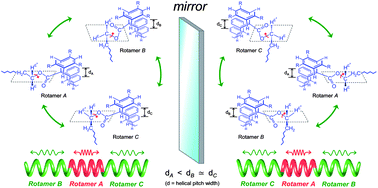An aliphatic substituted acetylene, n-heptyl propiolate, was stereoregularly polymerised using a catalyst, [Rh(nbd)Cl]2, at 40 °C in methanol to obtain the corresponding helical polymer, PnHepP. The changes in the line shapes and splitting patterns of the 1H NMR spectra were interpreted consistently as representing restricted rotation around the ester O–Cε bond in –O–CεHε2(R)– (R = n-hexyl alkyl chains), rather than helix inversion, with the aid of a 3-site jump model. A two-line peak corresponding to the ester methylene protons of –O–CH2– observed at 30 °C suggested the formation of three rotamers designated as A, B, and C based on the presence of contracted helix and stretched helix forms, each of which has an intrinsic helical pitch with a helical cis–cisoid structure. Furthermore, an accordion-like helix oscillation (HELIOS) along the main chain axis was proposed to explain the temperature dependence of spectral changes observed in the 1H NMR, UV-vis, and IR spectra. The temperature dependence of the UV-vis and 1H NMR spectra of PnHepP corroborated the presence of contracted and stretched one-handed helix sense polymers in solution.

